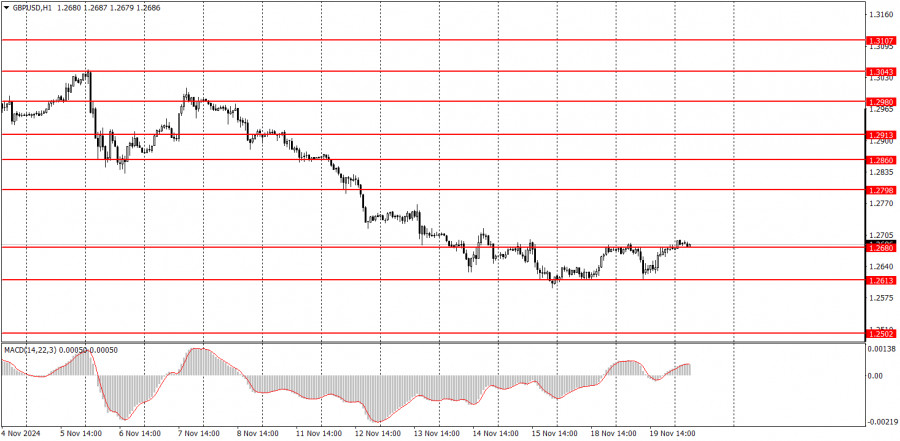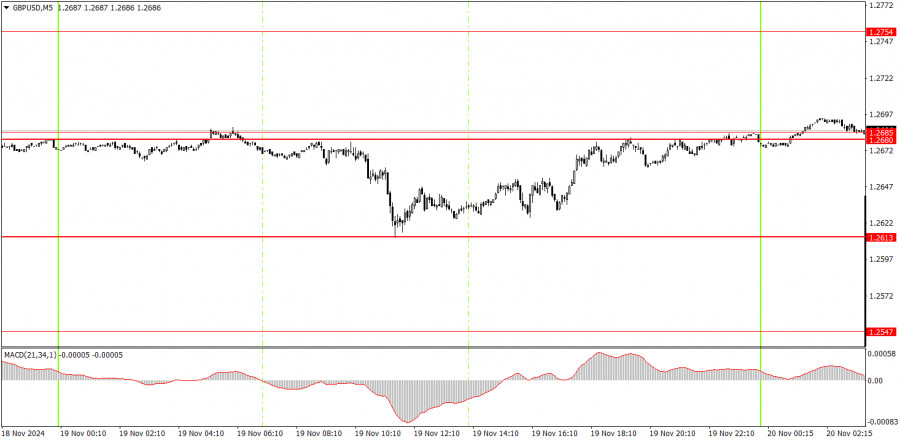

On Tuesday, the GBP/USD pair attempted to initiate an upward correction but failed again. Market participants are unwilling to buy the pound, and we agree entirely with this sentiment. Like the euro, the pound rallied for too long without enough justification. The market focused on a single factor for an extended period while ignoring all others. We are witnessing a process of "restoring fairness," which we believe is far from over.
In just a few hours, the UK will release its October inflation report, which could trigger increased volatility and sharp price swings. However, it is unlikely to reverse the ongoing downward trend; at best, it might facilitate a brief correction.
5M Chart of GBP/USD
Only one interesting trading signal formed on Tuesday in the 5-minute timeframe. During the European session, the price rebounded from the 1.2680-1.2685 zone, triggering a decline to the 1.2613 level. However, 1.2613 is newly refined, so novice traders could lock in profits from short positions anywhere. That said, the buy signal near 1.2613 was not considered.
Trading Strategy for Wednesday:GBP/USD remains inclined toward a downward movement on the hourly timeframe. In the medium term, we fully support the pound's decline, as we consider it the only logical scenario. The pound may attempt another correction in the short term, but such a move would require substantial support. Last Thursday, Jerome Powell provided no such support. Last Friday, macroeconomic data also failed to lend support. Today, the pound's fate hinges on the inflation report.
For Wednesday, novice traders can anticipate a resumption of the downward trend, but much will depend on the UK inflation data.
On the 5-minute TF, you can now trade at 1.2502-1.2508, 1.2547, 1.2633, 1.2680-1.2685, 1.2754, 1.2791-1.2798, 1.2848-1.2860, 1.2913, 1.2980-1.2993. On Wednesday, only one report is likely to attract traders' attention, but it is the most important release of the week. UK inflation data directly impacts the Bank of England's monetary policy, so the market reaction could be significant.
Core Trading System Rules:Signal Strength: The strength of a signal is measured by the time it takes to form (a rebound or level breakthrough). The shorter the time, the stronger the signal.False Signals: If two or more trades near a level result in false signals, all subsequent signals from that level should be ignored.Flat Markets: Pairs may generate numerous false signals or none during a flat market. Stop trading at the first signs of a flat market.Trading Hours: Open trades between the start of the European session and the middle of the US session. Close all trades manually afterward.MACD Signals: Trade MACD signals on the hourly timeframe only when there is good volatility and a trend confirmed by trendlines or channels.Close Levels: If two levels are close (5–20 pips apart), treat them as a support or resistance area.Stop Loss: Place a Stop Loss at breakeven after the price moves 20 pips in the intended direction.Key Chart Elements:Support and Resistance Levels: Target levels for opening or closing positions. Take Profit orders can also be set here.
Red Lines: Channels or trendlines that show the current trend and the preferred trading direction.
MACD Indicator (14,22,3): A histogram and signal line that serve as supplementary trading signals.
Important Events and Reports: Found in the economic calendar, these can strongly influence price movements. During their release, trade cautiously or exit the market to avoid sharp reversals against the preceding trend.
Forex beginners should remember that not every trade will be profitable. Developing a clear strategy and practicing proper money management are critical for long-term success in trading.